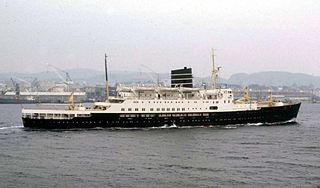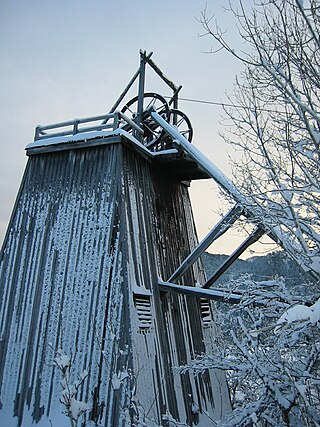
Transport in Norway is highly influenced by Norway's low population density, narrow shape and rugged coastline. Norway has old water transport traditions, but road, rail and air transport have increased in importance during the 20th century. Due to the low population density, public transport is somewhat less built out in rural areas of Norway, however public transport in and around cities is well developed.

The Norwegian railway system comprises 4,109 km of 1,435 mm track of which 2,644 km is electrified and 274 km double track. There are 697 tunnels and 2,760 bridges.

The Nordland Line is a 729-kilometer (453 mi) railway line between Trondheim and Bodø, Norway. It is the longest in Norway and lacks electrification. The route runs through Trøndelag and Nordland counties, carrying a combination of commuter, long-haul passenger and freight trains. From Trondheim Central Station to Steinkjer Station the line is most heavily used, with hourly services by the Trøndelag Commuter Rail. There are three branch lines—the Stavne–Leangen Line at Leangen Station, the Meråker Line at Hell Station and the Namsos Line at Grong Station.

European route E39 is the designation of a 1,330-kilometre (830 mi) north–south road in Norway and Denmark from Klett, just south of Trondheim, to Aalborg via Bergen, Stavanger and Kristiansand. In total, there are nine ferries, more than any other single road in Europe.

Orkanger is a town and the administrative centre of Orkland municipality in Trøndelag county, Norway. The town is also a former municipality which existed from 1920 until 1963. The town sits at the end of the Orkdal Fjord, an arm of the Trondheimsfjord. Orkanger is the commercial centre of the municipality of Orkland and it is the site of the Orkanger Church. It was established as a "town" in 2014.

The Thamshavn Line was Norway's first electric railway, running from 1908 to 1974 in what is now Trøndelag county. Today it is operated as a heritage railway and is the world's oldest railway running on its original alternating current electrification scheme, using 6.6 kV 25 Hz AC. It was built to transport pyrites from the mines at Løkken Verk to the port at Thamshavn, as well as passengers. There were six stations: Thamshavn, Orkanger, Bårdshaug, Fannrem, Solbusøy and Svorkmo. The tracks were extended to Løkken Verk in 1910.

Trondheim Central Station or Trondheim S is the main railway station serving the city of Trondheim, Norway. Located at Brattøra in the north part of the city centre, it is the terminus of the Dovre Line, running southwards, and the Nordland Line, which runs north. The railway is electrified south of the station but not north of it, so through trains must change locomotives at the station.

The Trøndelag Commuter Rail is a commuter train service operating in Trøndelag county, Norway. It was operated with Class 92 diesel multiple units by Vy, until 7 June 2020, when SJ Norge took over the contract until 2030. The service provides a commuter service connecting Trondheim Municipality to its suburbs, between towns in Innherred and as an airport rail link for Trondheim Airport, Værnes. Although passenger services have operated along the lines since 1864, the commuter train was created with an increase of service with existing rolling stock in 1993. In 2019, the system was used by 1.4 million passengers.
The Thamshavn Line sabotage was a series of sabotages against the railway Thamshavn Line in Orkdal Municipality, Norway during World War II. There were four separate sabotages, all performed by Company Linge in an attempt by the Norwegian resistance to prevent Germany from getting the pyrites that were being extracted at the mine at Løkken Verk.

Løkken Verk is a village in Orkland Municipality in Trøndelag county, Norway. It is located 5 kilometres (3.1 mi) south of the village of Svorkmo, 2 kilometres (1.2 mi) east of the village of Bjørnli, and 10 kilometres (6.2 mi) north of the municipal center of Meldal.
Elkem Thamshavn is a smelting plant owned by Elkem located at Thamshavn just north of Orkanger in Orkland Municipality in Trøndelag county, Norway. The plant produces silicon and microsilica and was started in 1931.

Thamshamn or Thamshavn is a small port village in Orkland Municipality in Trøndelag county, Norway. It is the site of the port for the town of Orkanger and the ferrosilicon plant Elkem Thamshavn. It is located right along European route E39 and is the Thamshavn Station was the terminus of the Thamshavnbanen railway.
Chr. Salvesen & Chr. Thams's Communications Aktieselskab, Salvesen & Thams, Comms. AS or S&T is a Norwegian company based at Løkken Verk in Meldal Municipality that was responsible for electricity production and railway operation for Løkken Mine operated by the Orkla Mining Company. After the mine closed in 1987 it has been turned into a development company to try to create new jobs at Løkken.

The Bergen Steamship Company (BDS), was founded in 1851 by Michael Krohn to operate a shipping service between the Norwegian ports of Bergen, Stavanger, and Kristiansand and the German port of Hamburg with the paddle steamer Bergen. The company funnel was black with three widely spaced narrow white bands.

Peter Vogelius Deinboll, DSO, MC was a Norwegian engineer, and resistance member during World War II.

The Løkken Mine is an underground pyrite mine located in the municipality of Orkland in Trøndelag, Norway. The mine was operative from 1654 to 1987, from the mining community Løkken Verk. It contained the largest deposits of its kind in Norway. Between 1654 and 1845, a total of 11,300 tons of copper was produced from the mine. From 1904 the mine was run by the company Orkla Grube-Aktiebolag, and until 1987 a total of 24 million tons of pyrite was produced from the mine. In addition to sulphur, the pyrite contained about 2% copper, in addition to zinc and traces of silver and gold. The products were originally transported to the sea by horse and sledge during winter time. From 1908 the ore was transported by the Thamshavn Line, which was the first electrical railway line in Norway. The annual production was about 350,000 tons of ore during its final years.
Wilhelm August Thams was a Norwegian merchant, land owner and lumber mill owner.

Orkla Mining Company Ltd. was a Norwegian mining company established in 1904. The company was the largest mining company in Norway in the aftermath of World War I, and was among the world's largest pyrite producers. After closing of the mining operations in 1987, the company developed into the holding company Orkla ASA, which is among the largest companies at Oslo Stock Exchange.

Trondheim Airport, Jonsvatnet was a water aerodrome located at Valset on the lake of Jonsvatnet in Trondheim, Norway. The airport was built as the first permanent airport serving Trondheim and initially was used for Norwegian Air Lines' (DNL) routes which commenced in 1935. Ahead of the 1936 season, the airport was equipped with permanent installations, including wharfs and a small terminal building. In 1937, the airport was used by Widerøe, before DNL returned the following year.

Orkdal Fjord (English) or Orkdalsfjorden (Norwegian) is a branch of the Trondheim Fjord located in Orkland Municipality and Skaun Municipality in Trøndelag county, Norway.
















